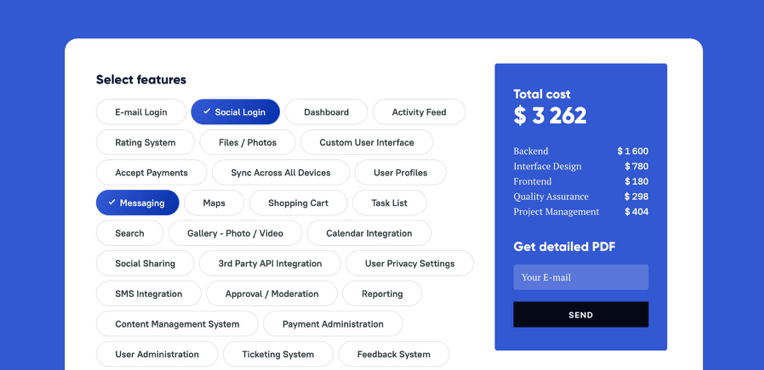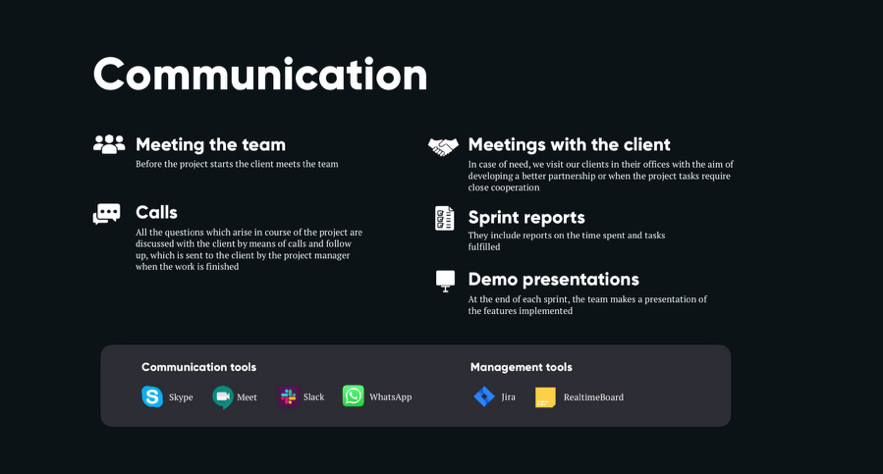How to Determine the Cost of Development For Your Project

How to Determine the Cost of Development For Your Project
Contributed ContentDetermining the cost of a project is something everyone prioritizes but is typically more complex than anyone prepares for. Considering the technical, non-technical, and unexpected factors of a development project are crucial for creating a realistic, fair budget.
Updated 08/04/2023
The cost of software product development is complex to estimate and there are certain factors to consider. Some of them depend on product type and specifics, but there are also external aspects to take into account.
There is hardly a business owner today that doesn’t understand the necessity and benefits of digital solutions for commercial needs. However, the cost of these software development solutions is vague for many people.
Our company, Stfalcon, knows it first hand since we have launched more than 135 projects in the recent decade and thoroughly discussed each one with a client. We’re sure there are no two identical products and processes out there and the complexity of each project should be weighed equally.
Yet, it’s not only these aspects that contribute to price of development. There are several vital factors to have an accurate budget estimation that you’ll learn about below.
Several Factors Determine the Cost of Software Development Projects
No matter the software solution of the development budget, it will be near-impossible to ballpark an accurate estimate or cost breakdown without a firm understanding of what factors are the biggest needle-movers for cost.
Generally, the more complex projects demand bigger project budgets. However, companies can use these factors to estimate costs and communicate with stakeholders in the project planning phase, before app development companies are brought into the fold.
- Project scope: the scope of the project will determine the software development process and should be communicated to involved team members upfront. For instance, a back-end-only project will often cost less than an entire mobile app builds with front-end, back-end, and UX design requirements. To help get a software development cost estimation, companies can look to similar projects completed by software development teams.
- Project team: Teams will likely include a Scrum master, developers, user experience experts, QA engineers, user interface specialists, and business analysts. Larger teams offer more scalability and potential for speedy optimizations, but will come at a higher cost. Similarly, outsourcing a dedicated team to augment current efforts can also be pricey because of the time and attention that approach demands.
- Tech stack: the type of software used by a software development team will differ with the needs and methodology preferred by the client. A startup’s SaaS app will not need the same tools as a large-scale e-commerce site. Some technologies may incur additional costs if it requires more complex resources or specialized personnel.
- Time frame: As many software development companies employ hourly rate pricing models, development time directly affects the overall cost. Clients can avoid time-consuming efforts resulting from scope creep with effective communication, expectations, and regular touchpoints with the team.
- Deliverables: Similar to project scope, the required deliverables indicate the effort a team needs to put into a project. For instance, creating a custom software MVP will require several rounds of iterations, UX design feedback, QA testing, dedicated back-end efforts, and more. Clients requiring a la carte services rather than a full-service solution may not pay as much because fewer deliverables are involved.
Using these levers, you can foresee and exert control over potential project estimations for software development collaboration. Now that you’re familiar with levers you can pull to lessen costs, it’s time to dive further into methods of determining development costs.
The Main Ways to Understand Development Costs for Your Project
- Understand the Two Types of Factors: Technical and Non-Technical
- Identify the Software-Dependent Factors
- Know the Type of Product
- Target Which Platforms to Use
- Determine Your Set of Features
- Additional Stages of Development to Consider
- Choose Your Design
- Perform Testing on the Product
- Plan for Project Management Tools
- Recognize the Non-Software Factors (Non-Technical)
- Choose the Correct Hiring Option
- Identify the Personnel Needed
- Pick a Location
- Consider Extra Non-Technical Expenses
Understand the Two Types of Factors: Technical and Non-Technical
The factors determining the costs of any IT product creation can be divided into two groups: technical and non-technical. The first group comprises of software-dependent factors: IT solution type, target platforms, features required, and additional technical-related requirements. The second group involves non-software-related factors like hiring, personnel, location, and more.
However, you shouldn’t forget about the fluctuating, hidden variables that may become visible during the process. These may require some extra time and resources to get the product work properly outside of the factors you’ve accounted for.
Now we can focus on key factors influencing development costs and find out how to predict extra expenditures.
Identify the Software-Dependent Factors (Technical)
Naturally, software-dependent factors will be the most obvious aspect when considering project pricing. However, there are various layers to consider about this portion of the work.
Know the Type of Product
Different web and mobile solutions need different approaches and routines in their development, so it’s the first major factor a business owner should consider. As the world becomes more mobile, applications are one of the most desired products.
Roughly, these products can be subdivided into three classes according to the complexity level: basic (simple, built quickly), medium (more complicated functionalities), and complex (intricate architecture, multiple integrations, require security).
While the core project cost is easy to assess because it doesn’t depend on any other software, integrated type of products present project constraints that need to be adhered to, firstly, consider the system and then the unpredictable factors, which set in during the integration.
Target Which Platforms to Use
The most common platforms for software development are web, iOS, and Android. The price varies depending on the platform, but there are also cross-platform solutions, which may help to save on smaller projects.
It’s vital to remember that an iOS solution cannot be converted into Android one, and vice versa, due to the difference in programming languages. That’s why identifying your target users and choosing the right platform should be done carefully at the beginning.
Determine Your Set of Features
It’s not enough to have a simple idea about what you need, it’s necessary to define the functionality of it and to describe each feature. You should at least know the functions it’ll perform and the problems it should solve for a user.
A good helping hand for figuring out these aspects can be an interactive calculator, like the one on Stfalcon site below.

Not only can it help someone estimate the cost of their product, but it clarifies what features you should consider for the scope.
Choose Your Design
The cost of development can be influenced by design choice. The design stage should be considered when determining the overall project’s price. Even if you’ve already decided your design approach, account for likely customizations during the development.
Perform Testing on the Product
It’s essential to do some form of testing on any product. This stage can change depending on the project's complexity, but it should never be neglected. They development phase should include various components of testing. It should be done to eliminate bugs and as an overall operation to ensure everything runs smoothly and correctly.
Plan for Project Management Tools
Some companies include project management within their cost estimation. Though it may seem unnecessary to some clients, it helps to plan and manage work properly while avoiding miscommunications. Like mentioned below, you can meet the team and make calls using various tools, enabling more communication.

Project management also includes reports, presentations, and meetings that result in saved time and resources in the end.
Recognize the Non-Software Factors (Non-Technical)
The final cost of solution development is determined by certain non-technical factors and most of them are staff-related. These factors are determined by a developer’s level of expertise, location, and degree of involvement.
Quality and dedication are valuable factors and should be earning market rates is contingent on the team carrying the project out and the infrastructure necessary for the solution's faultless operation.
Choose the Correct Hiring Option
IT staff are typically hired for a project in one of three ways: freelance specialists, in-house teammates, or subcontracting companies.
Employing freelancers is typically the cheapest option, but it may not be the most reliable. It isn’t easy to control the freelancer’s activity and outputs, deadlines or quality.
Hiring an in-house development team is the option that typically requires the most time and financial investment - salaries, taxes, hard- and software purchasing. With this option, the client has immediate access to the staff and the opportunity to control the whole development process.
Today the most popular and reliable option is contracting an outsourced IT company. Several benefits exist: many choices worldwide, affordable rates, and contract protection. The only main drawback is timezone differences, but those can be worked around.
Identify the Personnel Needed
Each solution requires an individual approach and staff working on it. During the estimation process, the development team's expertise should be considered. On the one hand, the professionals with more expertise may have higher rates, but they could likely finish the work quicker.
Software engineers are classified as junior, middle, and senior. Junior developers work in a team with more qualified colleagues and rely on their support. Middle developers can carry the project out independently, coping with occasional technical complications. Senior creators provide not only the service but may also be the most efficient option.
If your solution is simple, junior developers should be a good option. However, the more complicated the task, the more skilled the developer should be. Besides, in this case, there is an additional benefit in cooperation with the outsourced teams due to the code review process. In such a case the work performed by the junior is always checked by the senior.
Pick a Location
In the digital space, there are no borders when hiring a team. Because of this, developers can be found in various regions, impacting the project's cost. The rates for software development vary more than you’d think.
In the United States, the average cost of a developer can be between $80–$180 per hour. Australia, also being one of the most expensive, has an average cost of development of around $70 per hour.
However, oftentimes, the same quality can be delivered by specialists from Eastern Europe, costing between $40-$60 per hour.
Modern platforms facilitate project management and communication with development teams overseas. Slack, Microsoft Teams or Rocket Chat help create a comfortable virtual workplace for any team, so working with someone overseas isn’t an issue.
Consider Extra Non-Technical Expenses
There are also additional expenses that aren’t as obvious but still influence the final product pricing. It’s essential to take into consideration the so-called infrastructure cost. For example, the prices of purchasing or renting software or hardware are a factor. Along with that, maintenance fees, backup and training fees, and product and security upgrades all belong in this category.
Bottom Line: Consider the Price of Every Element of the Project
The cost of custom IT product development is complicated and a tricky thing to figure out. The most important takeaway is to consider every aspect, both technical and not.
Like our company, everyone should be sure to accurately assess the possible costs and leave enough leeway for variables. Even though there remains a chance for some failures, they can be brought to a minimum in such a way. Knowing all of the diverse factors that influence costs also means you’ll have a better understanding of your product and can optimize your budget.
The price of a great solution isn’t often low, but keeping all of the cost-influencing factors in mind will benefit your budget and bring a high ROI to your business.
